Oxymoron,Antithesis,Transferred Epithet
poetic devices
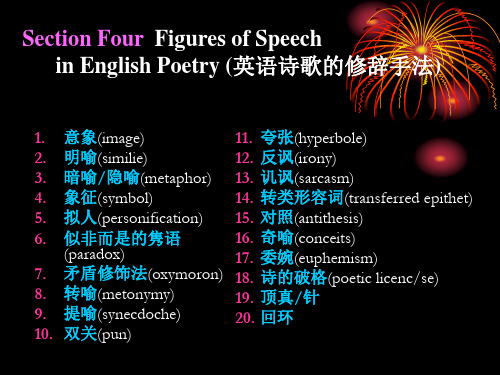
1. images (意像):
• words or phrases that communicate sensory experiences and convey moods and emotions: • (1) The apparition of these faces in the crowd; • Petals on a wet, black bough. (In a Station of the Metro) • (2) 枯藤老树昏鸦,/小桥流水人家,/古道西风瘦马。 夕阳西下,/断肠人在天涯。 • (3) 日暮苍山远,天寒白屋贫。/柴门闻犬吠,/风雪夜归人。 • (4) 去年今日此门中,/人面桃花相映红。/人面不知何处去,/ • 桃花依旧笑春风。
• An important kind of metonymy is synecdoche, in which the name of a part is substituted for that of a whole (e.g. hand for worker), or vice versa. • e.g. hand: They were short of hands at harvest time. (part for whole) • head: He paid the workers $5 per head. (part for whole) • heart: Yet there were some stout hearts who attempted resistance. • legs: The legs could hardly keep up with the tanks. (part for whole) • bread: Give us this day our daily bread (prayer). (part for whole) • They say there’s bread and work for all. (part for whole) • Australia beat Canada at cricket. (whole for part) • The car conked out. (whole for part) • • • The plane’s flamed out! The radio (TV) is out of order. (whole for part) (whole for part) (冯翠华 1983:54-55)
常用生物学专业英语词汇同名
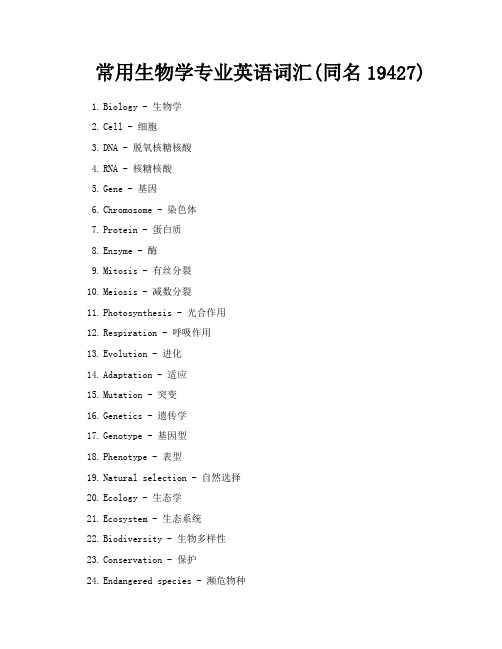
常用生物学专业英语词汇(同名19427)1.Biology - 生物学2.Cell - 细胞3.DNA - 脱氧核糖核酸4.RNA - 核糖核酸5.Gene - 基因6.Chromosome - 染色体7.Protein - 蛋白质8.Enzyme - 酶9.Mitosis - 有丝分裂10.Meiosis - 减数分裂11.Photosynthesis - 光合作用12.Respiration - 呼吸作用13.Evolution - 进化14.Adaptation - 适应15.Mutation - 突变16.Genetics - 遗传学17.Genotype - 基因型18.Phenotype - 表型19.Natural selection - 自然选择20.Ecology - 生态学21.Ecosystem - 生态系统22.Biodiversity - 生物多样性23.Conservation - 保护24.Endangered species - 濒危物种25.Extinction - 灭绝26.Classification - 分类27.Taxonomy - 分类学28.Kingdom - 界29.Phylum - 门30.Class - 纲31.Order - 目32.Family - 科33.Genus - 属34.Species - 种35.Anatomy - 解剖学36.Physiology - 生理学37.Microbiology - 微生物学38.Virology - 病毒学39.Immunology - 免疫学40.Biotechnology - 生物技术41.Genetic engineering - 基因工程42.Cloning - 克隆43.Stem cells - 干细胞44.Embryology - 胚胎学45.Developmental biology - 发育生物学46.Neurobiology - 神经生物学47.Botany - 植物学48.Zoology - 动物学49.Entomology - 昆虫学50.Marine biology - 海洋生物学51.Ornithology - 鸟类学52.Herpetology - 爬行动物学53.Mammalogy - 哺乳动物学54.Ecology - 生态学55.Population - 种群munity - 群落57.Ecosystem - 生态系统58.Habitat - 栖息地59.Food chain - 食物链60.Food web - 食物网61.Trophic level - 营养级62.Producer - 生产者63.Consumer - 消费者64.Decomposer - 分解者65.Mutualism - 互利共生66.Parasitism - 寄生mensalism - 共生68.Biome - 生物群落69.Tundra - 苔原70.Desert - 沙漠71.Grassland - 草原72.Forest - 森林73.Rainforest - 热带雨林74.Freshwater - 淡水75.Marine - 海洋76.Estuary - 河口77.Wetland - 湿地78.Adaptation - 适应79.Migration - 迁徙80.Hibernation - 冬眠81.Camouflage - 伪装82.Mimicry - 拟态83.Symbiosis - 共生84.Reproduction - 繁殖85.Asexual reproduction - 无性繁殖86.Sexual reproduction - 有性繁殖87.Fertilization - 受精88.Gamete - 配子89.Ovum - 卵子90.Sperm - 精子91.Pollination - 授粉92.Seed dispersal - 种子传播93.Germination - 发芽94.Growth - 生长95.Development - 发育96.Metabolism - 新陈代谢97.Homeostasis - 动态平衡98.Nervous system - 神经系统99.Digestive system - 消化系统100.Respiratory system - 呼吸系统。
(英语)英语综合综合试题回忆版真题完整版

(英语)英语综合综合试题回忆版题型一:30个词义辨析,这个考的很细节。
题型二:5个修辞手法,要自己会写题型三:150字左右的汉翻英题型四:150字左右的英英summary题型五:名词解释(语言学和文学各两个)1 derivation2 language3 Hamlet4 The lost generation题型六:整张试卷的重难点1 如何添加新词(英语语言的词汇丰富过程)2 尽可能多的写出“it is cold outside”的会话意义2 试尽可能多的写出The love song of Alfred Prufrock中Prufrock 的性格特点3 分析Thomas Hardy 的作品Tess of D’urbervilles 中TESS 这一人物2014年英语综合试题回忆版一30个词义辨析二5个修辞三150字汉翻英四summary五名词解释1 clipping2 language3 transcendentalism4 Willam Wordsworth题型六:重难点1 从distinctive property 相关知识考察其是否能区分人与动物的肢体或面部语言2 用sense and reference 相关知识分析以下两个例子,(例子是中文的,其中一个例子内容大概是:一个小偷对时尚杂志很感兴趣,关注杂志中的时尚服装,对裁缝来说,他会注意服装口袋的裁剪制作,而在小偷看来,他特别关注时尚在于关注服装的口袋,请问对小偷来说,他更关注什么,为什么?2015 年英语综合试题回忆版一30个选择二五个修辞三翻译五个汉译英,五个英译汉四summary五名词解释1 language2 error analysis3 Saul Bellow4 Doris lessing六分析题1 重要的ways of word formation 都有哪些,至少说出三个2 给了五组句子,是歧义句,说出每组句子的歧义所在3 what is Naturalism 什么是自然主义,并举例说明4 分析劳伦斯的儿子与情人作品中的Paul2014 年教育综合真题教育学一名词解释1 学校课程2 教育智慧二简答题1 课程研制的过程有哪些?2 教师劳动有哪些特点三论述如何理解人的全面发展?全面发展与个性发展的关系心理学一名词解释1 首因效应2 学校心理咨询二简答题1 什么是实验法,使用实验法时应该注意哪些事项2 影响问题解决的心理因素有哪些3 情绪情感在学习中的作用三论述题如何激发学生的学习动机,提高学生的学习效率2013年教育综合真题教育学一名词解释1 教育价值2 学校管理二简答题1 什么是教育个体功能2 影响课程实施的因素3 教育目的的定向功能具体表现在哪些方面4 有指导的教育学习指的是什么三论述教师应当具有怎么样的学生观心理学一名词解释1 社会知觉2 性格二简答1 使用测验法和调查法时应注意哪些事项2 注意分配依赖的条件3 想象的功能4 教师在教学工作中的角色和任务三论述智力发展的特征、影响因素、怎样开发学生的智力2012年教育综合真题教育学一名词解释1 教学模式2 教学功能二简答1 德育的一般规律2 班主任如何管理班级3 教师专业化发展的途径三论述论述新课改的趋势心理学一名词解释1 行为矫正治疗2 内隐记忆二简答1 知觉有哪些特性2 为什么说大脑是心理的主观能动性的器官3 教师为什么要学习心理学三论述论述教师应具备什么样的心理素质2011年教育综合真题教育学一名词解释1 教育制度2 国家课程二简答1 信息社会教育的主要特征2 我国教育目的的精神实质3 教师的职业角色三论述1 试述程序性教学知识及其教学设计2 为什么说教师的研究属于行为研究心理学一名词解释1 感觉2 性格3 能力4 再造想象二简答1 影响随意注意的因素有哪些2 情绪和情感的功能3 哪些心理因素影响问题解决三论述再创造性思维定义及其特点。
英语修辞方法概括。
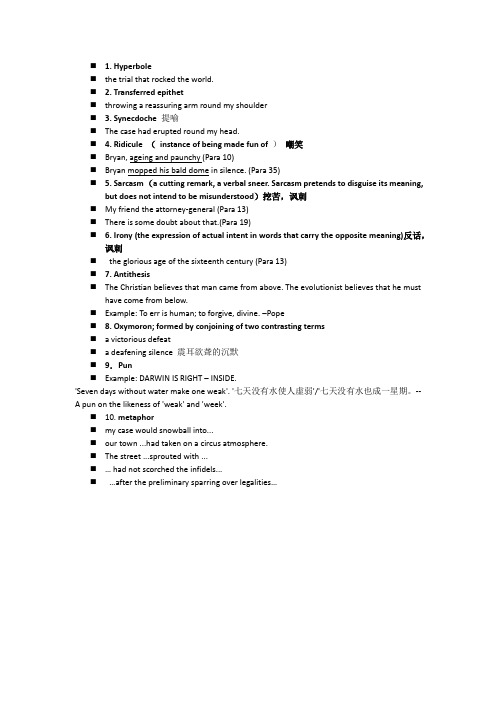
⏹ 1. Hyperbole⏹the trial that rocked the world.⏹ 2. Transferred epithet⏹throwing a reassuring arm round my shoulder⏹ 3. Synecdoche提喻⏹The case had erupted round my head.⏹ 4. Ridicule (instance of being made fun of)嘲笑⏹Bryan, ageing and paunchy (Para 10)⏹Bryan mopped his bald dome in silence. (Para 35)⏹ 5. Sarcasm (a cutting remark, a verbal sneer. Sarcasm pretends to disguise its meaning,but does not intend to be misunderstood)挖苦,讽刺⏹My friend the attorney-general (Para 13)⏹There is some doubt about that.(Para 19)⏹ 6. Irony (the expression of actual intent in words that carry the opposite meaning)反话,讽刺⏹the glorious age of the sixteenth century (Para 13)⏹7. Antithesis⏹The Christian believes that man came from above. The evolutionist believes that he musthave come from below.⏹Example: To err is human; to forgive, divine. –Pope⏹8. Oxymoron;formed by conjoining of two contrasting terms⏹ a victorious defeat⏹ a deafening silence 震耳欲聋的沉默⏹9.Pun⏹Example: DARWIN IS RIGHT – INSIDE.'Seven days without water make one weak'. '七天没有水使人虚弱'/'七天没有水也成一星期。
高级英语第三版第一册1-7课修辞整理
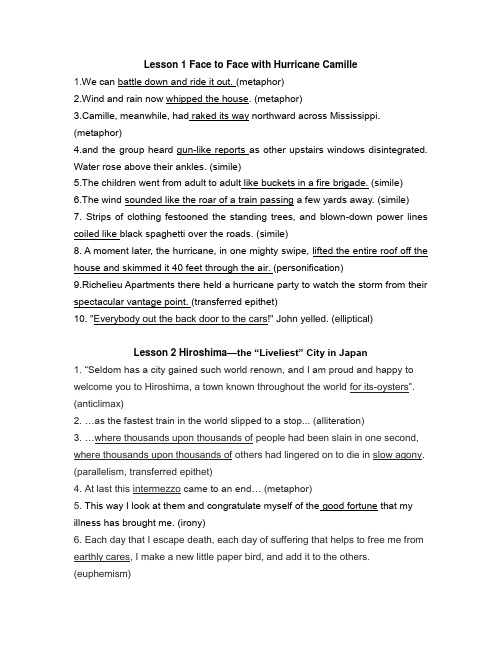
Lesson 1 Face to Face with Hurricane Camille1.We can battle down and ride it out. (metaphor)2.Wind and rain now whipped the house. (metaphor)3.Camille, meanwhile, had raked its way northward across Mississippi. (metaphor)4.and the group heard gun-like reports as other upstairs windows disintegrated. Water rose above their ankles. (simile)5.The children went from adult to adult like buckets in a fire brigade. (simile)6.The wind sounded like the roar of a train passing a few yards away. (simile)7.Strips of clothing festooned the standing trees, and blown-down power lines coiled like black spaghetti over the roads. (simile)8. A moment later, the hurricane, in one mighty swipe, lifted the entire roof off the house and skimmed it 40 feet through the air. (personification)9.Richelieu Apartments there held a hurricane party to watch the storm from their spectacular vantage point. (transferred epithet)10. "Everybody out the back door to the cars!" John yelled. (elliptical)Lesson 2 Hiroshima—the “Liveliest” City in Japan1. “Seldom has a city gained such world renown, and I am proud and happy to welcome you to Hiroshima, a town known throughout the world for its-oysters”. (anticlimax)2. …as the fastest train in the world slipped to a stop... (alliteration)3. …where thousands upon thousands of people had been slain in one second, where thousands upon thousands of others had lingered on to die in slow agony. (parallelism, transferred epithet)4. At last this intermezzo came to an end… (metaphor)5. This way I look at them and congratulate myself of the good fortune that my illness has brought me. (irony)6. Each day that I escape death, each day of suffering that helps to free me from earthly cares, I make a new little paper bird, and add it to the others. (euphemism)7. Hiroshima—the “liveliest” [pun]City in Japan(irony)8. I felt sick, and ever since then they have been testing and treating me. (alliteration)9. The rather arresting spectacle of little old Japan adrift amid beige concrete skyscrapers is the very symbol of the incessant struggle between the kimono and the miniskirt (synecdoche, metonymy)10. There were fresh bows, and the faces grew more and more serious each time the name Hiroshima was repeated. (synecdoche)11. Was I not at the scene of the crime? (rhetorical question)12. Because I had a lump in my throat…. (metaphor)13. Whose door popped open at the very sight of a traveler. (onomatopoeia)14.No one talks about it any more, and no one wants to, especially the peo ple who were born here or who lived through it. (climax)Lesson 3 Blackmail1.As a result the nerves of both duke and duchess were excessively frayed when the muted buzzer of the outer door eventually sounded. (metaphor)2. His wife shot him a swift, warning glance. (metaphor)3. You drove there in your fancy Jaguar, and you took a lady friend.(euphemism)4. The Duchess of Croydon kept firm, tight rein on her racing mind.(metaphor)5. In what conceivable way does our car concern you? (rhetorical question)6. Her voice was a whiplash. (metaphor)7. The obese body shook in an appreciative chuckle. (transferred epithet)8. Two high points of color appeared in the paleness of the Duchess of Croydon’s cheeks. (transferred epithet)9. The house detective clucked his tongue reprovingly. (onomatopoeia)10. Eyes bored into him. (metaphor)Lesson 4 A Trial that Rocked the World1) The trial that rocked the world (hyperbole)2) Darrow had whispered throwing a reassuring arm round my shoulder (transferred epithet)3) The case had erupted round my head (synecdoche)4) Bryan, ageing and paunchy, was assisted (ridicule)5) and it is a mighty strong combination (sarcasm)6) until we are marching backwards to the glorious age of the sixteenth century (irony)7) There is some doubt about that. (sarcasm)8) No one, ... that may case would snowball into...(metaphor)9) The streets around the three-storey red brick law court sprouted with rickety stands selling hot… (metaphor)10) Resolutely he strode to the stand, [carrying a palm fan like a sword to repel his enemies]. (ridicule, simile)11) Bryan mopped his bald dome in silence. (ridicule)12) Dudley Field Malene called my conviction a “victorious defeat” (oxymoron)13) ...our town ...had taken on a circus atmosphere. (metaphor)14) He thundered in his sonorous organ tones. (metaphor)15)...champion had not scorched the infidels... (metaphor)16)…after the preliminary sparring over legalities… (metaphor)17)Now Darrow sprang his trump card by calling Bryan as a … n. (metaphor)18)Then the court broke into a storm of applause that … (metaphor)19)...swept the arena like a prairie fire (simile)20)The oratorical storm … blew up in the little court in Dayton swept like a fresh wind (simile)21)...tomorrow the magazines, the books, the newspapers... (Metonymy)22) The Christian believes that man came from above. The evolutionist believes that he must have come from below. (Metonymy)23)His reputation as an authority on Scripture is recognized throughout the world. (Hyperbole)24)The Christian believes that man came from above. The evolutionist believes t hat he must have come from below. (antithesis)25)when bigots lighted faggots to burn... (Consonance)26) There is never a duel with the truth," he roared. "The truth always wins -- and we are not afraid of it. The truth does not need Mr. Bryan. The truth is eternal. (Repetition)27)Darrow walked slowly round the baking court. (transferred epithet)28)Gone was the fierce fervor of the days when Bryan had swept the political are na like a prairie fire.(Alliteration)29) DARWIN IS RIGHT—INSIDE(pun)Lesson 5 The Libido for the Ugly1. Here was the very heart of industrial America, the center of its most lucrative and characteristic activity (metaphor, transferred epithet, antithesis)2. Here was wealth beyond computation, almost beyond imagination--and here were human habitations so abominable that they would have disgraced a race of alley cats. (Antithesis, Repetition, hyperbole)3. There was not one in sight from the train that did not insult and lacerate the age. (synecdoche)4. There was not a single decent house within eye range from the Pittsburgh to the Greensburg yards. There was not one that was misshapen, and there was not one that was not shabby. (Understatement; Litotes)5. The country is not uncomely, despite the grim of the endless mills. (Litotes, Overstatement)6. They would have perfected a chalet to hug the hillsides. (personification)7. On their low sides they bury themselves swinishly in the mud. (Metaphor)8. And one and all they are streaked in grim, with dead and eczematous patches of paint peeping through the streaks. (Metaphor)9. When it has taken on the patina of the mills, it is the color of a fried egg. When it has taken on the patina of the mills, it is the color of an egg long past all hope or caring. (Metaphor, ridicule)10. I award this championship only after laborious research and incessant prayer.(Irony, sarcasm)11. N.J. and Newport News, Va.Safe in a Pullman, I have whirled through the gloomy… (Metonymy)12. But in the American village and small town the pull is always towards ugliness, and in that Westmoreland valley it has been yielded to with an eagerness bordering upon passion. (Ridicule)13. It is incredible that mere ignorance should have achieved such masterpieces of horror. (Irony)14. On certain levels of the American race, indeed, there seems to be positive libido for the ugly, as on the other and less Christian levels there is a libido for the beautiful. (Antithesis)15. The taste for them is as enigmatical and yet as common as the taste for the dogmatic theology and the poetry of Edgar A.Guest. (Metaphor)16. And some of them are appreciably better. (Sarcasm)17. They let it mellow into its present shocking depravity. (Metaphor; sarcasm)18. The effect is that of a fat woman with a black eye. (Metaphor)19. The boast and pride of the richest and grandest nation ever seen on earth. (hyperbole)20. What I allude to is the unbroken and agonizing ugliness, the sheer revolting monstrousness of every house in sight. (hyperbole)21. A steel stadium like a huge rat-trap somewhere further down the line. (simile, ridicule)22. Obviously, if there were architects of any professional sense of dinity in the region, they would have perfected a chalet to hug the hillsides. (sarcasm)23. By the hundreds and thousands these abominable houses cover the bare hillsides, like gravestones in some gigantic and decaying cemetery. (simile)24. They have the most loathsome towns and villages ever seen by a mortal eye. (hyperbole)25. They are incomparable in color, and they are incomparable in design. (sarcasm)26. It is as if some titanic and aberrant genius, uncompromisingly inimical to man, had devoted all ingenuity of Hell to the making of them. (hyperbole and irony)27. Beside it, the Parthenon would no doubt offend them. (sarcasm)28. In precisely the same way the authors of the rat-trap stadium that I have mentioned made a deliberate choice. (metaphor)29. They made it perfect in their own sight by putting a completely impossible penthouse, painted a starting yellow, on top of it. (ridicule)30. The effect is that of a fat woman with a black eye. (metaphor)31. It is that of a Presbyterian grinning. (metaphor)32. This they have converted into a thing… low-pitched roof. (inversion)33. But nowhere on this earth, at home or abroad, have I seen anything to compare to the village(inversion)34. coal and steel town(synecdoche)35. boy and man(synecdoche)36. Was it necessary to adopt that shocking color? (rhetorical question)37. Are they so frightful because the valley is full of foreigners – dull, insensate brutes, with no love of beauty in them? (rhetorical question)38. a crazy little church. (transferred epithet)39. a bare leprous hill (transferred epithet)40. preposterous brick piers (transferred epithet)41. uremic yellow (transferred epithet)42. the obscene humor (transferred epithet)Lesson 6 Mark Twain --- Mirror of America1)saw clearly ahead a black wall of night... (Metaphor)2)main artery of transportation in the young nation's heart(Metaphor)3)All would resurface in his books...that he soaked up... (Metaphor)4)When railroads began drying up the demand... (Metaphor)5)...the epidemic of gold and silver fever... (Metaphor)6)Twain began digging his way to regional fame... Mark Twain honed and experimented with his new writing muscles... (Metaphor)7)Most American remember M. T. as the father of... ...a memory that seemed phonographic(Simile)8) America laughed with him. (Hyperbole, personification)9)...to literature's enduring gratitude...(Personification)10)the grave world smiles as usual... (Personification)11) Bitterness fed on the man who had made the world laugh (Personification)12)America laughed with him. (Personification)13)...between what people claim to be and what they really are… (Antithesis)14)...a world which will lament them a day and forget them forever(Antithesis)15)… a motley band of Confederate guerrillas who diligently avoided contact with the enemy. (Euphemism)16)...the slow, sleepy, sluggish-brained sloths stayed at home(Alliteration)17)...with a dash and daring... ...a recklessness of cost or consequences...(Alliteration)18)...his pen would prove mightier than his pickaxe (Metonymy)19)For eight months he flirted with the colossal wealth available to the lucky and the persistent, and was rebuffed. (metaphor)20)From the discouragement of his mining failures, Mark Twain began digging his way to regional fame as a newspaper reporter and humorist.(metaphor)21)He boarded the stagecoach for San Francisco, then and now a hotbed of hopeful young writers. (metaphor)22)he commented with a crushing sense of despair on men's final release from earthly struggles (euphemism)23) ...took unholy verbal shots at the Holy Land... (metaphor, antithesis)24) Most Americans remember ... the father of [Huck Finn's idyllic cruise through eternal boyhood and Tom Sawyer's endless summer of freedom and adventure.] (parallelism, hyperbole)25)The cast of characters set before him in his new profession was rich and varied --a cosmos (hyperbole)26) the vast basin drained three-quarters of the settled United States(metaphor)27) Steamboat decks teemed...main current of...but its flotsam(metaphor)28) Twain began digging his way to regional fame... (metaphor)29) life dealt him profound personal tragedies... (personification)30) the river had acquainted him with ... (personification)31) ...an entry that will determine his course forever... (personification)32) Personal tragedy haunted his entire life. (personification)33)Keelboats, ...carried the first major commerce (synecdoche)Lesson 7 Everyday Use for your grandmamma1. “Maggie’s brain is like an elephant’s”. Wangero said, laughing. (irony)2. “Mama,” Wangero said sweet as a bird. “can I have these old quilts?” (simile)3. …showing just enough of her thin body enveloped in pink skirt and red blouse… (metaphor)4. After I tripped over it two or three times he told me …(metaphor)5. And she stops and tries to dig a well in the sand with her toe. (hyperbole)6. Hair is all over his head a foot long and hanging from his chin like a kinky mule tail. (simile)7. Have you ever seen a lame animal, perhaps dog run over by some careless person rich enough to own a car, sidle up to someone who is ignorant enough to be kind of him? (metaphor)8. I feel my whole face warming from the heat waves it throws out. (hyperbole)9. Impressed with her they worshiped the well-turned phrase, the cute shape, the scalding humor that erupted like bubbles in lye. (simile)10. It is like an extended living room. (simile)11. Johnny Carson has much to do to keep up with my quick and witty tongue. (assonance)12. My skin is like an uncooked barley pancake. (simile)13. She gasped like a bee had stung her. (simile)14. You didn’t even have to look close to see where hands pushing the dasher up and down to make butter had left a kind of sink in the wood. (metaphor)15. Who ever knew a Johnson with a quick tongue? Who can even imagine me looking a strange white man in the eye? (rhetorical question)。
[原创]《英语修辞》作业参考答案
![[原创]《英语修辞》作业参考答案](https://img.taocdn.com/s3/m/55d58f265b8102d276a20029bd64783e09127d99.png)
《英语修辞》作业参考答案I.1.明喻引喻拟人平行通感矛盾修饰法提喻突降委婉语头韵隐喻对照移就隽语转喻层递低调陈述重复夸张元韵2.Metaphor Antithesis Transferred Epithet ParadoxMetonymy Climax Understatement RepetitionHyperbole Assonance Simile AllusionPersonification Parallelism Synaesthesia OxymoronSynecdoche Anticlimax Euphemism AlliterationII.1. C (Alliteration)2. A (Metaphor)3. B (Pun)4. B (Metonymy)5. D (Understatement)6.C (Euphemism)7. A (Allusion)8. A (Parallelism)9. D (Oxymoron) 10. B. (Anticlimax) 11. C (Simile) 12.D (Personification)13. A (Synaesthesia) 14. D (Synecdoche) 15. B (Hyperbole) 16.B (Antithesis); 17. A (Repetition) 18. C (Irony) 19. D (Parody) 20. C. (Zeugma)III.1.B (Anticlimax)2. D (Personification)3. C (Simile)4. D (Repetition)5. C (Euphemism)6. C (Rhetorical Question)7. A (Anastrophe) 8. C (Simile)9. A (Metaphor) 10. C (Alliterarion)11.D (Oxymoron) 12. C (Simile)13.B (Transferred Epithet) 14. A (Synaesthesia)15. B (Pun) 16. C (Simile)17. B (Pun) 18 D (Parallelism)19. A (Metaphor) 20. D (Understatement)IV.1.Simile2. Transferred Epithet3. Euphemism4. Synecdoche5. Hyperbole6. Parallelism7. Climax 8. Assonance 9. Parody10. Palindrome 11. Metaphor 12. Synaesthesia13. Understatement 14. Allusion 15. Paradox16. Repetition 17. Pun 18. Zeugma19. Malapropism 20. Rhetorical Question 21.Simile22. Metaphor 23. Anticlimax; 24.Simile25.Understatement 26. Personification;V1.C (Simile); D (Personification)2. A (Parallelism); B (Antithesis); D (Repetition);3. B (Metaphor); C (Allusion); D (Anastrophe)4. B (Hyperbole); D (Syllepsis)5. C (Simile); D (Personification)6. B (Antithesis); C (Alliteration); D (Metonymy)7. A (Metaphor); D (Personification);8. B (Climax); D (Repetition)9. B (Antithesis); C (Oxymoron)10. A (Pun); C (Rhetorical Question)11. B (Hyperbole); D (Personification)12. A (Metaphor); D (Personification);13. A (Metaphor); C (Irony)14. B (Hyperbole); C (Climax)15.2. C (Simile); D (Personification);16.A (Antithesis); C (Alliteration); D (Pun)VI.省略VII.AParagraph (1) Alliteration, SimileParagraph (2) ParallelismParagraph (3) Personification, Verb-MetaphorParagraph (4) Personification, AlliterationParagraph (5) MetaphorBParagraph (1) Understatement, SimileParagraph (2) Alliteration, Parallelism,Paragraph (3) Parallelism,Paragraph (4) Antithesis, MetaphorParagraph (5) Personification, Alliteration, ParallelismCParagraph (1) Parallelism, PersonificationParagraph (2) Parallelism, PersonificationParagraph (3) Antithesis, Climax, Metaphor, Allusion, Parallelism, Personification Paragraph (4) ParallelismDParagraph (1) HyperboleParagraph (2) Assonance, Consonance, AllusionParagraph (3)Paragraph (4) Metaphor。
Lesson 10修辞和Paraphrase-08
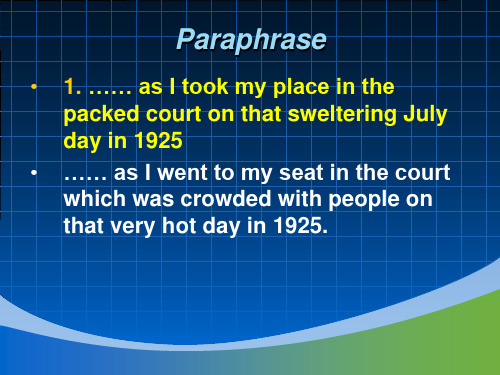
intent in words that carry the opposite meaning. It is an effective literarபைடு நூலகம் device because it gives the impression of great restraint.
• •
Paraphrase
• • 11. The spectators chuckled and Bryan warned to his work. The audience chuckled (laughed quietly) and Bryan was encouraged by the audience’s appreciation of his sarcasm and become more enthusiastic.
The figures of speech
• • • • A victorious defeat A living death Cruel kindness Parting is such sweet sorrow.
• “睁眼瞎” • 真实的谎言
back
The figures of speech
Paraphrase
• 15. When Malone finished there was a momentary hush. Then the court broke into a storm of applause that surpassed that for Bryan. When Malone finished it was silent for only a very brief time and then there was outburst of applause, greater than Bryan had received.
生物分子学英文单词
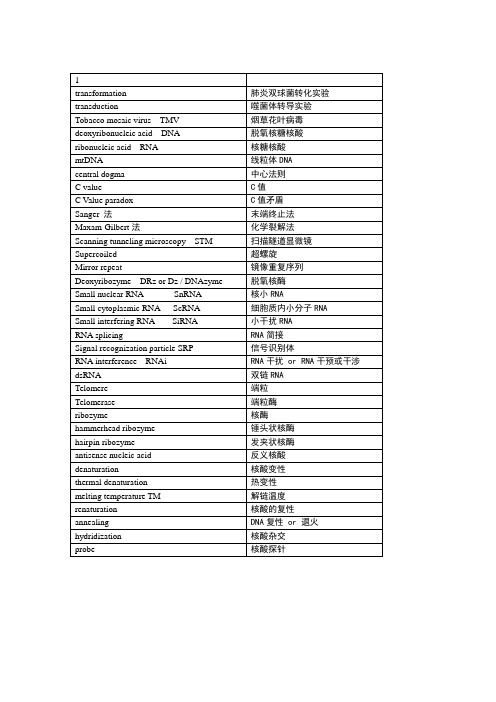
operon
操纵子
a coordinated unit of gene expression
基因表达的协同单位
cis-acting element
顺式作用元件
trans-acting factor
反式作用因子
sequence specific DNA binding protein
序列特异性DNA结合蛋白
micRNA
mRNA干扰性互补RNA
folding enzymes,foldases
折叠酶
molecular chaperone
分子伴侣
signal peptide
信号肽
plaque signal
信号斑
motif
基序
zinc finger
锌指结构
leucine zipper motif
亮氨酸拉链
domain
诱发突变
mutagen
诱发剂
mutagenesis
突变生成作用
mutant gene
突变基因
mutant
突变体
substitution
碱基置换突变
frame shift mutation
移码突变
transition
转换
transversion
颠换
synonymous mutation
同义突变
missense mutation
插入序列
inverted reprats IR
反向重复序列
IS-like elements
类插入序列
β-lactamase
β-内酰胺
activator/dissociation体系
高级英语第一册 Unit10 The trial that rocked the world

怒发冲冠,凭栏处,萧萧雨歇。抬望眼仰天长啸, 壮怀激烈。(岳飞《满江红》)
自春来,惨绿愁红,芳心事事可可。(柳永《定风 波》)
fundamentalist movement
a clash between the fundamentalists and the modernists. The fundamentalists: a literal interpretation of the Old Testament
When, where, why, who
The first day of the trial
The judge called for a local minister to open the session with prayer, and the trial got under way.
The climax of the trial
The trial was resumed outside under the maples. Darrow sprang his trump card by calling Bryan as a witness for the defence.
The climax of the trial
Transferred epithet
Franklin Roosevelt listened with bright-eyed smiling attention, saying nothing, and applauding heartily with the rest. 富兰克林 · 罗斯福目光炯炯,满脸笑容,聚精会神地 听着;他没说什么,只是跟大伙儿开心地鼓掌喝彩。 相思枕上的长夜,怎样的厌厌难尽啊!(闻一多 《红豆》)
医学生理学名词解释

、|!_一个人总要走陌生的路,看陌生的风景,听陌生的歌,然后在某个不经意的瞬间,你会发现,原本费尽心机想要忘记的事情真的就这么忘记了..1. Negative feedback:负反馈:在一个闭环系统中,控制部分活动受受控部分反馈信号(Sf)的影响而变化,若Sf为负,则为负反馈。
其作用是输出变量受到扰动时系统能及时反应,调整偏差信息(Se),以使输出稳定在参考点(Si)。
2. homeostasis(稳态):内环境的理化性质不是绝对静止的,而是各种物质在不断转换之中达到相对平衡状态,即动态平衡,这种平衡状态为稳态。
3. Autoregulation:自身调节,指组织、细胞在不依赖于外来的神经和体液调节情况下,自身对刺激发生的适应性反应过程。
4. Paracrine:旁分泌,内分泌细胞分泌的激素通过细胞外液扩散而作用于临近靶细胞的作用方式。
5. 局部电位:由阈下刺激引起局部膜去极化(局部反应),引起邻近一小片膜产生类似去极化。
主要包括感受器电位,突触后电位及电刺激产生的电紧张电位。
特点:分级;不传导;可以相加或相减;随时间和距离而衰减。
6. 内向电流:指细胞膜激活时发生的跨膜正离子内向流动或负离子外向流动。
7. fluid mosaic model:液态镶嵌模型,是有关膜的分子结构的假说,内容是膜的共同特点是以液态的脂质双分子层为骨架,其中镶嵌有具有不同分子结构、因而也具有不同生理功能的蛋白质。
8. 跳跃式传导:有髓纤维受外加刺激时,动作电位只能发生在相邻的朗飞结之间,跨髓鞘传递。
9. 膜片钳:用来测量单通道跨膜的离子电流和电导的装置。
10. 后负荷:指肌肉开始收缩时遇到的阻力。
11. 横桥:肌凝蛋白的膨大的球状部突出在粗肌丝的表面,它与细肌丝接触共同组成横桥结构。
它对肌丝的滑动有重要意义。
12. 后电位:在锋电位下降支最后恢复到静息电位水平前,膜两侧电位还要经历一些微小而较缓慢的波动,称为后电位。
文学中几种常见的英语修辞手法及其翻译
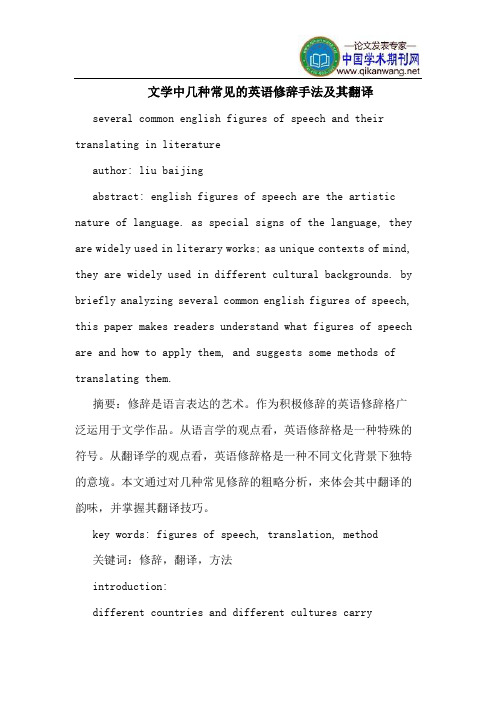
文学中几种常见的英语修辞手法及其翻译several common english figures of speech and their translating in literatureauthor: liu baijingabstract: english figures of speech are the artistic nature of language. as special signs of the language, they are widely used in literary works; as unique contexts of mind, they are widely used in different cultural backgrounds. by briefly analyzing several common english figures of speech, this paper makes readers understand what figures of speech are and how to apply them, and suggests some methods of translating them.摘要:修辞是语言表达的艺术。
作为积极修辞的英语修辞格广泛运用于文学作品。
从语言学的观点看,英语修辞格是一种特殊的符号。
从翻译学的观点看,英语修辞格是一种不同文化背景下独特的意境。
本文通过对几种常见修辞的粗略分析,来体会其中翻译的韵味,并掌握其翻译技巧。
key words: figures of speech, translation, method关键词:修辞,翻译,方法introduction:different countries and different cultures carrydifferent histories, but it makes us get together at the same time. language is a tool for people to convey their feelings and thoughts. in order to improve the effects of expression and strengthen the persuasion, people apply many varieties of methods. m.a.k halliday said: “each language has its own logic, own figures of speech, and own value of aesthetics.”so we find, figures of speech are the artistic nature of language.as special signs of the language, figures of speech are widely used in literary works; as unique contexts of mind, they are widely used in different cultural backgrounds. the categories of english figures of speech (feng cuihua. english figures of speech): simile, metaphor, analogy, personification, hyperbole, understatement, euphemism, metonymy, synecdoche, antonomasia, pun, zeugma, irony, innuendo, sarcasm, paradox, oxymoron, antithesis, epigram, climax, anti-climax, apostrophe, transferred-epithet, alliteration, onomatopoeia, and repetition.the charm of figures of speech in literature lies in its beauty of relation, beauty of change, beauty of harmony, and beauty of sound and color. now, let us analyze several commonenglish figures of speech in literature, and try to summarize the methods of translating them.1. simileit is a figure of speech, which makes a comparison between two unlike elements having at least one quality or characteristic in common. to make the comparison words like as ,as…as, as if, and like are used to transfer the quality we associate with one to the other.e.g. ①sore-eyed children clouds cluster of everywhere in unbelievable numbers, like clouds of flies.(“marrakech” ae1) 眼睛红肿的孩子随处可见,多的像一群群的苍蝇,数也数不清。
42-英语修辞学

中国海洋大学本科生课程大纲课程属性:公共基础/通识教育/学科基础/专业知识/工作技能,课程性质:必修、选修一、课程介绍1.课程描述:英语修辞学是研究人类使用英语互相交流、培养英语学习者使用英语进行交流能力的学科。
本课程针对高年级英语专业学生开设,课程内容包括修辞学的若干基本内容:修辞学的定义、三美、五言等基本概念以及西方修辞学理论、视觉修饰以及修辞活动涉及的词汇、句法、段落、修辞格等。
通过课程学习,要求学生掌握英语修辞学的基本理论内容和修辞方法等,并且能够利用这些理论方法对英语学习者过程中的实际问题进行分析,进而提高英语修辞能力,正确而恰当地使用英语,达到学习英语的目的。
This course will introduce the fundamental concepts of English rhetoric, such as the definition of rhetoric, three aesthetic criterion of rhetoric, five cannons of rhetoric. It will provide students with tools to deal with the rhetorical practice at lexical level, syntactic level, textual level. Topics will include western rhetorical theories, visual rhetoric, rhetoric in advertisements. By the discussion on these topics, students will be equipped with the theoretical and practical basis for English rhetoric in English learning with their rhetorical competence improved, using English properly and appropriately.- 6 -2.设计思路:本课程引导高年级英语专业学生通过修辞学来探讨和理解由实际问题所驱动的修辞在理论和应用两方面的发展途径。
分子生物学重要名词解释

分子生物学重要名词解释染色体(chromosome):原指真核生物细胞分裂中期具有一定形态特征的遗传物质载体。
现在这一概念已扩大为包括原核生物及细胞器在内的基因载体的总称。
染色质(chromatin):由DNA和蛋白质构成,在分裂间期染色体结构疏松,称为染色质。
其实染色质与染色体只是同一物质在不同细胞周期的表现。
常染色质(euchromatin):是进行活跃转录的部位,呈疏松的环状,电镜下表现为浅染,易被核酸酶在一些敏感的位点(hypersensitive sites)降解。
异染色质(heterochromatin):在间期核中处于凝缩状态,无转录活性,也叫非活动染色质(inactive chromatin),是遗传惰性区。
在细胞周期中表现为晚复制,早凝缩,即异固缩现象(heteropycnosis)。
组蛋白(histones):进化上非常保守的碱性蛋白质,是DNA的结合蛋白,也是染色体的结构蛋白,分H1、H2A、H2B、H3、H4五种,与DNA共同组成真核生物染色质的基本单位结构。
核小体(nucleosome):DNA绕在组蛋白八聚体(H2A、H2B、H3、H4各一对)核心外1.8周(146bp),形成核小体核心颗粒。
DNA多态性:指DNA序列中发生变异而导致的个体间核苷酸序列的差异,包括单核苷酸多态性、串联重复序列多态性。
SNP(single nucleotide polymorphism ):单核苷酸多态性,是指基因组DNA序列中单个核苷酸的突变引起的多态性。
包括转换、颠换、缺失和插入。
通过SNP可发现疾病相关基因突变,指导用药与药物设计,标记相邻的疾病基因。
端粒(telomere):真核生物线性基因组DNA末端的一种特殊结构,是一段DNA序列和蛋白质形成的复合体。
内含子(intron):原初转录物中经RNA拼接反应而被去除的RNA序列或基因中与这些RNA序列相应的DNA序列。
外显子(exon):在前体mRNA剪接(Splicing)后仍被保留下来、存在成熟mRNA中的RNA序列或与其对应的DNA序列,可在蛋白质生物合成过程中被表达为蛋白质。
高级英语第二册重点单词

Lashed冲击scudded 疾行desolate使荒凉, 孤寂derelict被遗弃的undoing 取消毁灭makings 做booming兴旺繁荣受欢迎的contemptuous轻蔑的侮辱的a catalytic agent催化剂sprees狂欢swiveled转换旋转smoldered闷烧lucrative有利可图的赚钱的macabre 可怕的adjunct催化剂industrious勤勉的afflict (distress)危难不幸frenzied (crazyrift gaptempered( toughened)diatribes (criticism)invoke (call forth)perspicacious (perceptive) contingent因情况而异的, 不一定的squashed压扁的压碎的precariously.Insecurelyputrid rotting腐败festooned coveredprovincial narrow-mindedgrueling耗尽denominator traitskin and bones皮包骨瘦的sit out袖手旁观indulge in susceptible to对……敏感, 易受影响Erectness 竖立安装hamlets 小村庄sanctuary避难所slashing猛砍, 鞭打猛烈agonizing 苦恼的unabated不减弱的doused 浸泡blasts爆炸marooned 孤立无援的dogmatic教条的unfathomable深不可测的plight 状况flayed criticizedin obedience to 遵照harassed troubled厌烦的dissipated.Disappearedwritten off 忽略不顾prescribed set downdiabolical.fiendish恶行unabated不减弱的不衰退的unleashed释放解放swath细长的列crooks骗取, 恶棍putrid decomposing分解marooned abandoned 孤立的blew in偶然采访, 挥霍infested 被骚扰的stowed装填存放smoldered闷烧inimical 故意的有害的skimmed浏览去除mellow成熟圆润的enlist从军支持wring拧绞catalytic agent催化剂lucrative有利可图的let-up减少减弱reluctant 不愿desultorily perplexing复杂的困惑的facetiously 爱开玩笑的summons 召唤engulf吞噬macabre ghastly 可怕的snapped 突然中断拍拍作响trailed尾随追踪hobbled 蹒跚inflamed发炎的红肿的tribulation苦难磨难contingent因情况而异的不一定的bordering upon相邻blasts爆炸inverted 倒转的反向的testimony证词证言slumped 下跌的diatribes 诽谤;恶骂restrains 保留denunciation 谴责obsolescent 过时的invective abusediabolical.Criticismwhipped up rousedturned belly up endedacute intenseoutgrown过快的过大的outpaced赶过超过forsaken 遗弃tempt诱惑引起rejection抛弃拒绝expatriation放弃国籍流亡国外lacerated撕裂受伤waif流浪者dingy昏暗的肮脏的mellowed 圆润的柔和的glimmer 少许微光闪光standardization标准imposingly壮观的威风的ardent热情的longed for coveted 渴望bewilderingobsolescent 过时的affluent 富裕的appalling 可怕的震惊的shattered 破碎的sullen sulky生气阴沉的scampered 奔跑devastated 毁坏in retrospect 回顾square substantial 大量的实质的derelict abandoned抛弃unfathomable incomprehensible深不可immune exempt 免除exempt 免除preposterous 荒谬的square substantialdubious questionablesquash squeeze挤压修辞Antithesis 对照Metonymy 借代Oxymoron 矛盾修辞Transferred epithet 转移转类修辞Alliteration 头韵Synecdoche提喻Assonance谐音Onomatopoeia 拟声。
大学英语四级修辞手法习题
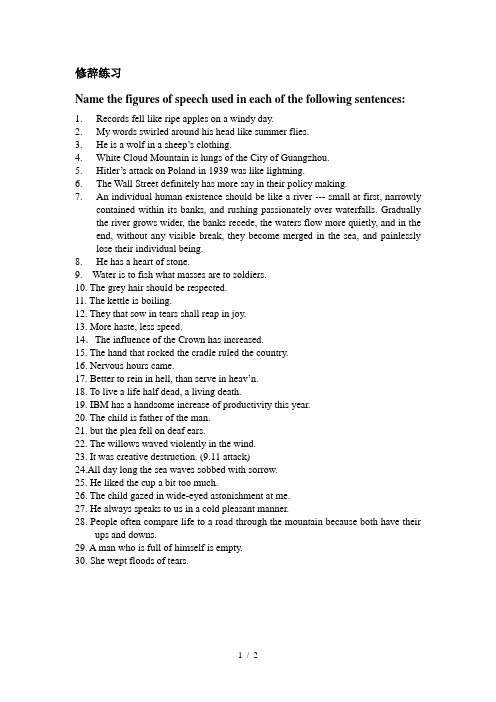
修辞练习Name the figures of speech used in each of the following sentences:1.Records fell like ripe apples on a windy day.2.My words swirled around his head like summer flies.3.He is a wolf in a sheep’s clothing.4.White Cloud Mountain is lungs of the City of Guangzhou.5.Hitler’s attack on Poland in 1939 was like lightning.6.The Wall Street definitely has more say in their policy making.7.An individual human existence should be like a river --- small at first, narrowlycontained within its banks, and rushing passionately over waterfalls. Gradually the river grows wider, the banks recede, the waters flow more quietly, and in the end, without any visible break, they become merged in the sea, and painlessly lose their individual being.8.He has a heart of stone.9. Water is to fish what masses are to soldiers.10. The grey hair should be respected.11. The kettle is boiling.12. They that sow in tears shall reap in joy.13. More haste, less speed.14.The influence of the Crown has increased.15. The hand that rocked the cradle ruled the country.16. Nervous hours came.17. Better to rein in hell, than serve in heav’n.18. To live a life half dead, a living death.19. IBM has a handsome increase of productivity this year.20. The child is father of the man.21. but the plea fell on deaf ears.22. The willows waved violently in the wind.23. It was creative destruction. (9.11 attack)24.All day long the sea waves sobbed with sorrow.25. He liked the cup a bit too much.26. The child gazed in wide-eyed astonishment at me.27. He always speaks to us in a cold pleasant manner.28. People often compare life to a road through the mountain because both have theirups and downs.29. A man who is full of himself is empty.30. She wept floods of tears.Keys:1. simile2.simile3. zoosemy (metaphor)4. metaphor5. simile6. metonymy7. analogy8. metaphor9. analogy 10. synecdoche (metonymy) 11. metonymy 12. antithesis 13. antithesis 14. metonymy 15. synecdoche 16. transferred epithet 17. antithesis 18. oxymoron 19. transferred epithet 20. paradox 21. synecdoche 22. alliteration 23. oxymoron 24. alliteration (personification) 25. metonymy 26. transferred epithet 27. oxymoron 28. analogy 29. paradox 30. hyperbole.。
高级英语修辞总结

Rhetorical Devices一、明喻(simile)是以两种具有相同特征的事物和现象进行对比,表明本体和喻体之间的相似关系,两者都在对比中出现。
常用比喻词like, as, as if, as though等,例如:1、This elephant is like a snake as anybody can see.这头象和任何人见到的一样像一条蛇。
2、He looked as if he had just stepped out of my book of fairytales and had passed me like a spirit.他看上去好像刚从我的童话故事书中走出来,像幽灵一样从我身旁走过去。
3、It has long leaves that sway in the wind like slim fingers reaching to touch something.它那长长的叶子在风中摆动,好像伸出纤细的手指去触摸什么东西似的。
二、隐喻(metaphor)这种比喻不通过比喻词进行,而是直接将用事物当作乙事物来描写,甲乙两事物之间的联系和相似之处是暗含的。
1、German guns and German planes rained down bombs, shells and bullets... 德国人的枪炮和飞机将炸弹、炮弹和子弹像暴雨一样倾泻下来。
2、The diamond department was the heart and center of the store.钻石部是商店的心脏和核心。
三、Allusion(暗引)其特点是不注明来源和出处,一般多引用人们熟知的关键词或词组,将其融合编织在作者的话语中。
引用的东西包括典故、谚语、成语、格言和俗语等。
英语引用最多的是源出《圣经》故事以及希腊、罗马神话、《伊索寓言》和那些源远流长的谚语、格言等。
例如:1、Grammar may be his heel of Achilles.语法是他的大弱点。
英语修辞手法
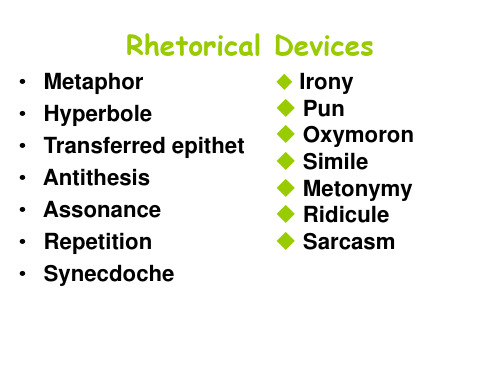
Ridicule (嘲弄,奚落)
• unkind descriptions that are intended to make someone or something seem stupid • 通常指用一些不太善意的或看起来比较滑稽 和夸张的语言对不良的或愚蠢的行为进行揭 露和批评。 • Example: Bryan, ageing and paunchy • Bryan mopped his bald dome in silence
Irony
(反语)
• a figure of speech that achieves emphasis by saying the opposite of what is meant, the intended meaning of the words being the opposite of their usual sense. • This form of irony is called verbal irony, and differs from the stylistic device of dramatic irony. • The use of words to express something different from and often opposite to their literal meaning. 用词语表达与它们的字面意思相异或相反的用法 • An expression or utterance marked by a deliberate contrast between apparent and intended meaning. 反语句以表面含义与实际含义相 反为特征的表达或措词
• I spoke to him in hesitant English. • He lives by honest labour.
英语修辞Word版
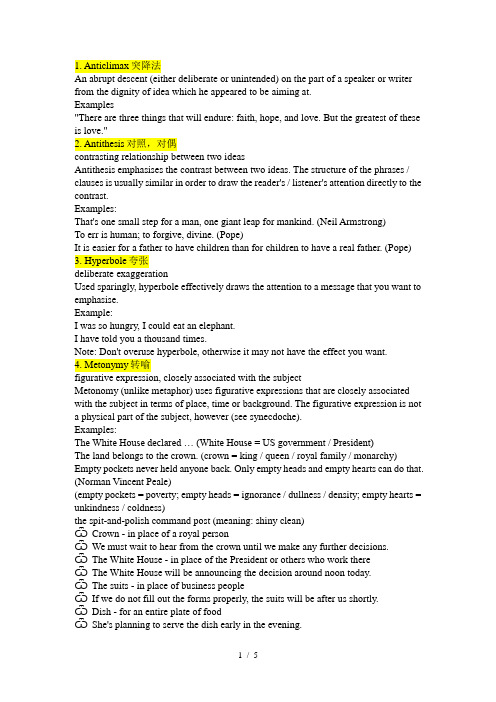
1. Anticlimax突降法An abrupt descent (either deliberate or unintended) on the part of a speaker or writer from the dignity of idea which he appeared to be aiming at.Examples"There are three things that will endure: faith, hope, and love. But the greatest of these is love."2. Antithesis对照,对偶contrasting relationship between two ideasAntithesis emphasises the contrast between two ideas. The structure of the phrases / clauses is usually similar in order to draw the reader's / listener's attention directly to the contrast.Examples:That's one small step for a man, one giant leap for mankind. (Neil Armstrong)To err is human; to forgive, divine. (Pope)It is easier for a father to have children than for children to have a real father. (Pope) 3. Hyperbole夸张deliberate exaggerationUsed sparingly, hyperbole effectively draws the attention to a message that you want to emphasise.Example:I was so hungry, I could eat an elephant.I have told you a thousand times.Note: Don't overuse hyperbole, otherwise it may not have the effect you want.4. Metonymy转喻figurative expression, closely associated with the subjectMetonomy (unlike metaphor) uses figurative expressions that are closely associated with the subject in terms of place, time or background. The figurative expression is not a physical part of the subject, however (see synecdoche).Examples:The White House declared … (White House = US government / President)The land belongs to the crown. (crown = king / queen / royal family / monarchy) Empty pockets never held anyone back. Only empty heads and empty hearts can do that. (Norman Vincent Peale)(empty pockets = poverty; empty heads = ignorance / dullness / density; empty hearts = unkindness / coldness)the spit-and-polish command post (meaning: shiny clean)ѾCrown - in place of a royal personѾWe must wait to hear from the crown until we make any further decisions.ѾThe White House - in place of the President or others who work thereѾThe White House will be announcing the decision around noon today.ѾThe suits - in place of business peopleѾIf we do not fill out the forms properly, the suits will be after us shortly.ѾDish - for an entire plate of foodѾShe's planning to serve the dish early in the evening.ѾCup - for a mugѾThe cup is quite tasty.ѾThe Pentagon - to refer to the staffѾThe Pentagon will be revealing the decision later on in the morning.ѾThe restaurant - to refer to the staffѾThe restaurant has been acting quite rude lately.ѾEars - for giving attention ("Lend me your ears!" from Mark Antony in Julius Caesar)ѾEyes - for sightѾLearn how to use your eyes properly!ѾThe library - for the staff or the booksѾThe library has been very helpful to the students this morning.ѾPen - for the written wordѾSword - for military mightѾSilver fox - for an attractive older manѾThat individual is quite the silver fox.ѾHand - for helpѾCan you please give me a hand carrying this box up the stairs?Ѿ"He writes a fine hand." - This means that the person writes neatly or has good handwriting.ѾThe name of a country - used in place of the government, economy, etc.ѾThe name of a church - used in place of its individual membersѾThe name of a sports team - used in place of its individual membersѾThe United States will be delivering the new product to us very soon.ѾSaint Thomas will be coming to the soup kitchen to help out next Sunday after Mass.ѾThe Yankees have been throwing the ball really well, and they have been hitting better than they have been in the past few seasons.ѾThe Oval Office was busy in work. (“The Oval Office” is a metonymy as it stands for people at work in the office.)ѾHollywood. (For US Cinema.)Ѿ the bottle for alcoholic drink, the press for journalism, skirt for woman, Mozart for Mozart's music, the Oval Office for the US presidencyѾHe is a man of cloth.- which means he belongs to a religious order.Ѿ Let's go to bed now.ѾGoing to bed is typically understood metonymically in the sense of 'going to sleep.' 5. ParadoxDefinition:A figure of speech in which a statement appears to contradict itself.Examples"War is peace.""Freedom is slavery.""Ignorance is strength."6. Pun 双关A play on words, sometimes on different senses of the same word and sometimes on the similar sense or sound of different words.Examples"Time flies like an arrow. Fruit flies like a banana."I would like to go to Holland someday. Wooden shoe?7. Synecdoche提喻using a part instead of the whole or vice versaSynechdoche is some kind of generalization or specification that uses a part, a member or a characteristic of what is meant. The following possibilities are common:Part used instead of the wholeExample:Turning our long boat round […] on the last morning required all hands on deck … (hands = people) (4)Whole used instead of a partExample:Troops halt the drivers (troops = soldiers) (3)Specific term used instead of a general one:Example:Kashmir is their Maui, Aspen, and Palm Springs all rolled into one. (3) (siehe Anmerkung)Note: For people from the US, every place represents a certain kind of holiday destination: Maui is a typical island in the sun, Aspen a typical ski resort, Palm Springs an attractive city with museums, theatres, shopping malls and festivals. Using the places instead of what they stand for is shorter, and the reader knows exactly that Kashmir combines everything you would expect to find in Maui, Aspen and Palm Springs.General term used instead of a specific one:Example:The animal came closer. (animal = a certain animal, e.g. a dog, dolphin, snake) Material used instead of the product:Example:She wore gold around her neck. (gold = chain)8. Transferred epithetA transferred epithet is a figure of speech in which an epithet (or adjective) grammatically qualifies a noun other than the person or thing it is actually describing. Also known in rhetoric as hypallage.A transferred epithet often involves shifting a modifier from the animate to the inanimate, as in the phrases "cheerful money," "sleepless night," and "suicidal sky." As I sat in the bath tub, soaping a meditative foot and singing, if I remember correctly, ‘Pale Hands I Loved Beside the Shalimar,’ it would be deceiving my public to say that I was feeling boomps-a-daisy."(P.G. Wodehouse, Jeeves and the Feudal Spirit, 1954)"We're coming close to those little creeks now, and we keep a discreet silence."(Henry Hollenbaugh, Rio San Pedro. Alondra Press, 2007)"[Peggotty] rubs everything that can be rubbed, until it shines, like her own honest forehead, with perpetual friction."9. OxymoronA compressed paradox (one that's expressed in just a few words) is called an oxymoron.An oxymoron is a figure of speech in which incongruous or seemingly contradictory terms appear side by side; a compressed paradox."Ralph, if you're gonna be a phony, you might as well be a real phony."(Richard Yates, "Saying Goodbye to Sally." The Collected Stories of Richard Yates. Picador, 2002)"Consider that when you pick up 'natural' pancake syrup from the grocery store, chances are that one of the listed ingredients will be 'natural flavoring'—an oxymoron." (Brian X. Chen, "Choosing the Best Smartphone Plan for You." The New York Times, September 2, 2015)10. Alliterationrepetition of initial consonant soundThe initial consonant sound is usually repeated in two neighbouring words (sometimes also in words that are not next to each other). Alliteration draws attention to the phrase and is often used for emphasis.Examples:for the greater good of ...safety and securityshare a continent but not a countryRepetition of initial consonant sounds means that only the sound must be the same, not the consonants themselves.Examples:killer commandfantastic philosophyA neat knot need not be re-knotted.If neighbouring words start with the same consonant but have a different initial sound, the words are not alliterated.Examples:a Canadian childhono ured and humbled (the ‘h’ in honoured is silent)11. Rhetorical Questionquestion without a direct answerThe author / speaker raises a question, but doesn't answer it directly as he/she sees the answer (usually Yes or No) as obvious.Rhetorical questions are used to provoke, emphasise or argue.Examples:When public money brings windfalls to a few, why should the state not take a share? But was the best way to win them over to threaten to ignore them altogether? Like so many things this week, the adminitstration's diplomacy needs a smoother touch. (Note that the sentence following the question is not an answer to it.)12. Metaphor13. Simile14. Personification15. Understatementweaken or soften a statementA statement is deliberately weakened to sound ironical or softened to sound more polite. Note that understatement is a common feature of the English language (especially British English) used in everyday-life situations.Examples:I know a little about running a company. (a successful businessman might modestly say.)I think we have slightly different opinions on this topic. (instead of: I don't agree with you at all.)[文档可能无法思考全面,请浏览后下载,另外祝您生活愉快,工作顺利,万事如意!]。
论文:文学中几种常见的英语修辞手法及其翻译
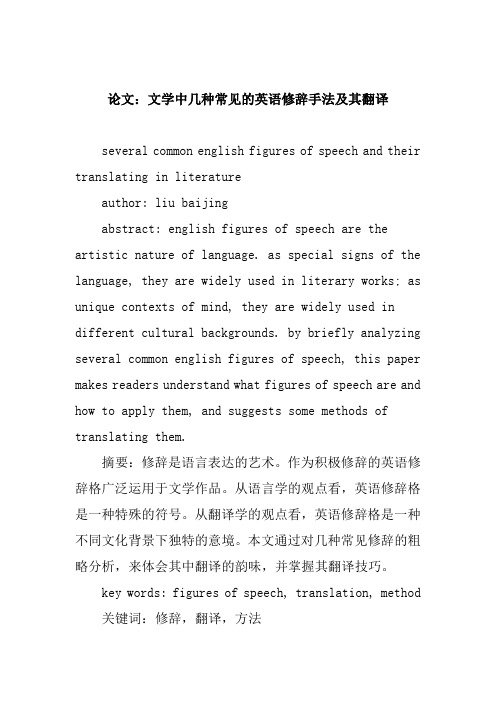
论文:文学中几种常见的英语修辞手法及其翻译several common english figures of speech and their translating in literatureauthor: liu baijingabstract: english figures of speech are the artistic nature of language. as special signs of the language, they are widely used in literary works; as unique contexts of mind, they are widely used in different cultural backgrounds. by briefly analyzing several common english figures of speech, this paper makes readers understand what figures of speech are and how to apply them, and suggests some methods of translating them.摘要:修辞是语言表达的艺术。
作为积极修辞的英语修辞格广泛运用于文学作品。
从语言学的观点看,英语修辞格是一种特殊的符号。
从翻译学的观点看,英语修辞格是一种不同文化背景下独特的意境。
本文通过对几种常见修辞的粗略分析,来体会其中翻译的韵味,并掌握其翻译技巧。
key words: figures of speech, translation, method 关键词:修辞,翻译,方法introduction:different countries and different cultures carry different histories, but it makes us get together at the same time. language is a tool for people to convey their feelings and thoughts. in order to improve the effects of expression and strengthen the persuasion, people apply many varieties of methods. m.a.k halliday said: “each language has its own logic, own figures of speech, and own value of aesthetics.” so we find, figures of speech are the artistic nature of language.as special signs of the language, figures of speech are widely used in literary works; as unique contexts of mind, they are widely used in different cultural backgrounds. the categories of english figures of speech (feng cuihua. english figures of speech): simile, metaphor, analogy, personification, hyperbole, understatement, euphemism, metonymy, synecdoche, antonomasia, pun, zeugma, irony, innuendo, sarcasm, paradox, oxymoron, antithesis, epigram, climax,anti-climax, apostrophe, transferred-epithet, alliteration, onomatopoeia, and repetition.the charm of figures of speech in literature liesin its beauty of relation, beauty of change, beauty of harmony, and beauty of sound and color. now, let us analyze several common english figures of speech in literature, and try to summarize the methods of translating them.1. simileit is a figure of speech, which makes a comparison between two unlike elements having at least one quality or characteristic in common. to make the comparison words like as ,as…as, as if, and like are used to transfer the quality we associate with one to the other.e.g. ①sore-eyed children clouds cluster of everywhere in unbelievable numbers, like clouds of flies.(“marrakech” ae1)眼睛红肿的孩子随处可见,多的像一群群的苍蝇,数也数不清。
- 1、下载文档前请自行甄别文档内容的完整性,平台不提供额外的编辑、内容补充、找答案等附加服务。
- 2、"仅部分预览"的文档,不可在线预览部分如存在完整性等问题,可反馈申请退款(可完整预览的文档不适用该条件!)。
- 3、如文档侵犯您的权益,请联系客服反馈,我们会尽快为您处理(人工客服工作时间:9:00-18:30)。
Soul Sister
Two forms:
Group1: Comparison between two aspects of one thing (一物两面对照)
Group2: Comparison between two things(两物对照)
7/14/2013
Soul Sister
Group1: Comparison between two aspects of one thing(一物两面对照) Examples:
7/14/2013
Group 3: adj. + sb. / sth. →adj. + another thing
Examples:
1.the noisy friendliness of a pub ①The child was noisy in the morning. ②It’s a noisy place.
《愤怒的葡萄》
Soul Sister
Three forms:
Group 1: adj. + sb.→ adj. + sth. Group 2: adj. + sth. → adj. + another thing Group 3: adj. + sb. / sth. → adj. + another thing
Soul Sister
Group 1: adj. + sb. → adj.+ sth. Examples: 1. a murderous knife a knife used by a murderous villain 2. my wild days, my mad existence the days when I was wild and mad
Oxymoron Antithesis
Transferred Epithet
Soul Sister
Oxymoron (矛盾修饰法)
Definition: An oxymoron is a compressed paradox formed by the conjoining of two contrasting, contradictory terms.
慈悲致死
Soul Sister
Five forms:
Group4: v. + adv. shine darkly die merrily
油黑发亮 快乐的死去
Group5: n. + n. a love-hate relationship; the sound of silence
7/14/2013
Antithesis (平行对照)
Definition:
It is a figure which gives the contrast of ideas by means of words, phrases, clauses, or sentences. It deliberately arranges contrast words or ideas in balanced structure for emphasis.
教育使一个民族易于引导,但却难于驾驭;易于管理, 但却不可能奴役。
Soul Sister
Group2: Comparison between two things (两物对照) Examples:
1. His fees were high; his lessons were light.
他的费收得很高,课却很轻。
7/14/2013
Soul Sister
Examples:
1.Knowledge makes humble, ignorance makes proud.
知识使人谦卑,无知使人骄傲。
2.A pessimist is one who makes difficulties of his opportunities; an optimist is one who makes opportunities of his difficulties.
2.the peaceful comfort of someone’s home ①Peaceful people are not violent. ②A peaceful place is quiet and calm.
7/14/2013
Soul Sister
Difference between Transferred Epithet
Oxymoron:
a loving hate or a hating love
Soul Sister
Effect:
矛盾修饰法语言精练简洁,利用词义层面上的 矛盾意义来揭示某一特定语境中的存在于复杂 客观世界的哲理和深刻内涵。 E.g. Beautiful tyrant! Fiend angelical! 美丽的暴君!天使般的魔鬼! Dove feather's raven! Wolfish--ravening lamb! 披着白鸽羽毛的乌鸦!残忍若豺狼的羔羊! Despised substance of divinest show! 圣洁的外表包着丑恶的祸心! Just opposite to what you justly have seen! 与你之所见恰恰相反! A damned saint, an honourable villain! 一个应受诅咒的圣人,一个诚实体面的恶棍! 7/14/2013 (Shakespeare, Romeo and Juliet) Soul Sister
悲观的人把机会变成困难,乐观的人将困难 化为机会。
7/14/2013
Soul Sister
Transferred Epithet(移就)
Definition:
It is a figure in which an adj. is transferred from the n. should be modified to another n. to which it does not belong.
Soul Sister
Difference between Oxymoron and
Paradox(隽语)
Oxymoron 是停留在短语层次上的修辞格, Paradox (隽语) 则属于句子层次上的修辞格。因 此,Oxymoron 被称为“condensed paradox”,即缩小的Paradox; Paradox 则是 “expanded oxymoron”,即扩大的 Oxymoron。 e.g. Paradox: I hate and love.
Байду номын сангаас
2. Large houses are still occupied while weavers’ cottages stand empty.
大房子仍然占据着,而纺织工人的小屋却空着。
Soul Sister
Difference between Antithesis and
Contrast(对照) 一般认为Antithesis属于句子结构上的修辞 格,Contrast是词义上的修辞格。两者有相 似之处,即都把意义相反的语言单位并列在 一起加以对照以突出差别;但也有相异之处, 主要在于 Contrast 不像 Antithesis 那样 要求结构匀称、排列整齐。
移就是指一种形容词从它本应该修饰的一 类名词转移到它本不应该修饰的一类名词 上的修辞手法。
Soul Sister
For example:
She is engaged in diahonest calling.
她从事的是不正当的职业
The Grapes of Wrath (John Seinbeck)
For example:
Words: up and down;
joys and sorrows. Phrases: a happy healthy man and a decrepit wreck. Clauses: If a free society cannot help the many who are poor, it cannot save the few who are rich. Sentences: They that sow in tears shall reap in joy.
Soul Sister
Examples:
1.Antithesis:Ask not what your
country can do for you, and ask what you can do for your country.
不要问国家能为你们做些什么,而要问你 们能为国家做些什么。
2.Contrast: Let both sides explore
1. Not that I loved Caesar less, but that I loved Rome more.
不是我不爱凯撒,而是我更爱罗马。
cation makes people easy to lead, but difficult to drive; easy to govern, but impossible to enslave.
对照是指通过意义完全相反的单词、短语、从句或者句 子来进行对比的修辞手法。它旨在在平衡的结构中安插 相对的词句以起强调作用。 Antithesis有两个特点:一是语义上的对照性,二是结 构上的对称性。因此,该辞格可看作是Parallelism (平行)与Contrast(对照)的结合, Soul Sister 故译作“平行对照”。
矛盾修饰法是把一对语意相反、相对立的词 巧妙地放在一起使用,借以表达复杂的思想 感情或说明某种意味深长的哲理。 Soul Sister
For example:
